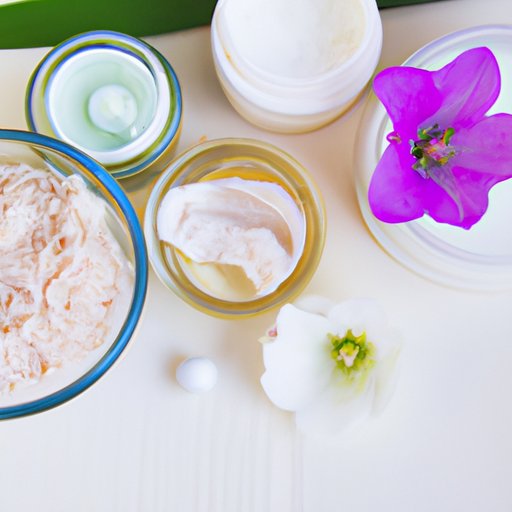Introduction
Skin texture refers to the roughness or smoothness of your skin. It can be caused by a variety of factors, such as sun exposure, aging, genetics, and lifestyle choices. If you’re looking to improve the texture of your skin, there are several steps you can take.
Exfoliate Regularly
Exfoliating is one of the most effective ways to get rid of skin texture. Exfoliation removes dead skin cells and unclogs pores, which helps to reduce the appearance of bumps and other uneven textures. By regularly exfoliating, you can help keep your skin looking smooth and healthy.
Benefits of Exfoliation
Regular exfoliation has several benefits for your skin. It helps to remove dirt, oil, and other buildup from the surface of your skin, which can lead to fewer breakouts. It also helps to stimulate cell turnover, allowing for new, healthy skin cells to grow and replace old ones. Additionally, exfoliation can help to increase circulation, leading to brighter, glowing skin.
Types of Exfoliants
There are many types of exfoliants available on the market. Physical exfoliants, such as scrubs and brushes, are usually made with small particles that slough away dead skin cells. Chemical exfoliants, on the other hand, use acids such as AHAs and BHAs to dissolve the bonds between dead skin cells. For best results, it’s important to choose an exfoliant that’s suited for your skin type.
Use a Retinoid Cream
Retinoid creams are another effective way to get rid of skin texture. Retinoids are derived from vitamin A, and they help to speed up the rate of cell turnover. This can help to minimize the appearance of wrinkles and fine lines, as well as reduce the appearance of bumps and uneven texture.
Benefits of Retinoid Creams
Retinoid creams have many benefits for your skin. They can help to reduce the appearance of wrinkles and fine lines, as well as diminish the look of dark spots and acne scars. Additionally, they can help to reduce oil production, which can help to prevent breakouts. Finally, retinoid creams can help to even out skin tone and texture.
How to Use Retinoid Creams
Retinoid creams should be used as part of your nighttime skincare routine. Before applying the cream, be sure to cleanse your face thoroughly. Then, apply a pea-sized amount of the cream to your face and gently massage it into your skin. Be sure to use sunscreen during the day, as retinoids can increase your skin’s sensitivity to the sun.
Use Salicylic Acid
Salicylic acid is another great option for getting rid of skin texture. It’s a type of beta hydroxy acid (BHA) that helps to exfoliate the skin and unclog pores. This can help to reduce the appearance of bumps and other uneven textures.
Benefits of Salicylic Acid
Salicylic acid has many benefits for your skin. It helps to exfoliate the skin, unclogging pores and reducing the appearance of bumps and uneven textures. It also helps to reduce oil production, which can help to prevent breakouts. Additionally, salicylic acid can help to reduce inflammation, which can help to reduce redness and irritation.
How to Use Salicylic Acid
Salicylic acid can be found in many skincare products, including cleansers, toners, masks, and moisturizers. It’s important to use a product that’s formulated for your skin type. For best results, it’s recommended to use a product with 0.5% to 2% salicylic acid. Be sure to follow the instructions on the product for best results.
Consider Professional Treatments
If you’re looking for more dramatic results, you may want to consider professional treatments. There are several treatments available that can help to improve the texture of your skin.
Overview of Professional Treatments
Professional treatments are performed by licensed professionals, such as dermatologists or aestheticians. These treatments can help to reduce the appearance of wrinkles, fine lines, and other skin imperfections. Depending on the treatment, there may be some downtime involved.
Types of Professional Treatments
Some of the most popular professional treatments include laser resurfacing, chemical peels, microdermabrasion, and dermal fillers. Laser resurfacing uses lasers to target specific areas of the skin, helping to reduce the appearance of wrinkles and fine lines. Chemical peels use a solution to peel away the top layer of skin, revealing younger, healthier skin underneath. Microdermabrasion uses a device to gently exfoliate the skin, removing dead skin cells and unclogging pores. Dermal fillers use a substance to fill in wrinkles and fine lines, giving the skin a smoother appearance.
Try Natural Remedies
In addition to professional treatments, there are also several natural remedies that can help to improve the texture of your skin. These remedies are often less expensive than professional treatments, and they can be done at home.
Benefits of Natural Remedies
Natural remedies are a great option for those who want to improve their skin without breaking the bank. Many natural remedies are gentle enough to be used on all skin types, and they can provide results without any downtime. Additionally, natural remedies can be used in conjunction with professional treatments for best results.
Examples of Natural Remedies
Some of the most popular natural remedies include honey masks, aloe vera gel, coconut oil, and oatmeal masks. Honey is a natural antibacterial that can help to reduce inflammation and fight breakouts. Aloe vera gel is a soothing ingredient that can help to reduce redness and irritation. Coconut oil is a natural moisturizer that can help to soften the skin. Oatmeal masks are great for exfoliating the skin, removing dead skin cells and leaving the skin feeling soft and smooth.
Conclusion
Getting rid of skin texture can be a challenge, but it’s not impossible. By following the tips above, you can help to improve the texture of your skin. It’s important to remember to exfoliate regularly, use retinoid creams, use salicylic acid, and consider professional treatments if needed. Additionally, you can try natural remedies to help improve the texture of your skin. If you’re still having trouble, be sure to seek professional help.


